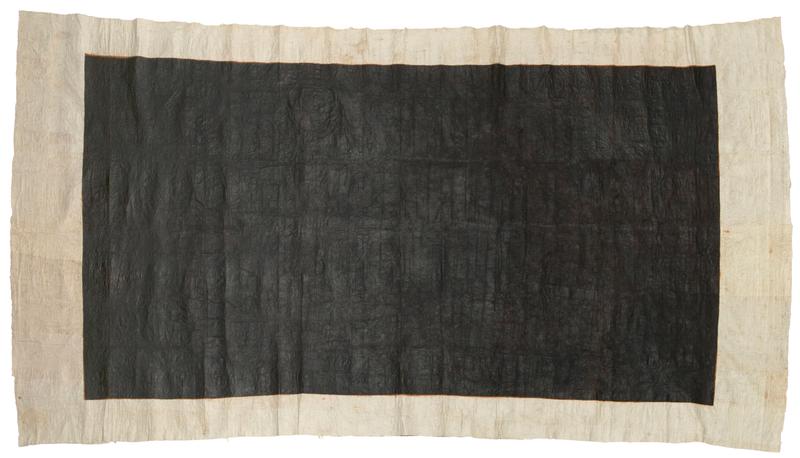Reviewed by John Daly-Peoples

Robin White, This is me at Kaitangata
Robin White: Something is happening Here
Auckland City Art Gallery\
Until January 30th 2023
Reviewed by John Daly-Peoples
Robin White: Te Whanaketanga | Something is Happening Here is a marvellous retrospective exhibition of work by contemporary New Zealand artist Dame Robin White.
The works range across fifty years, from her early colourful prints of herself, family, friends and her local environment to the large collaborative works she has undertaken with artists from across the Pacific, including Japanese artists Keiko Iimura and Taeko Ogawa and her large-scale tapa works with Tongan artists, Ruha and Ebonie Fifita, and Fijian artist, Tamari Cabeikanacea.

Robin White. Soon the tide will turn
In “Soon the tide will turn” one of her large collaborative barkcloth works the artist includes a small image based on a painting of hers from fifty years before. It is of the building which dominates “Mangaweka” but without the old Bedford truck sitting outside. The two works illustrate her commitment to recognising place and her links to the land across time. For many artists their work is an expression of and a contemplation of their physical, emotional and spiritual connections, with White the images she has created constitute a visual diary of the places she has lived, the environments she has inhabited and the people she has encountered.

Robin White, Mangaweka
As she has previously said of her work “A consistent thread in my work it that it’s made in response to place and what’s happening around me – physical and social environments provide raw material, the inspiration and the starting point”
This connection with family and community is noticeable in the early works such as images of Sam Hunt, Claudia Pond Eyley, her mother Florence and her son Michael. Then at the end of the exhibition there is the large diptych “Aoi ngairo – This is us” in which she depicts members of her village.

Ronin White. Clouds, Hill and Claudia
The exhibition follows her career from the early successes, selling work to the University of Auckland and The Dowse through to her relocation to Kiribati. It traces out the development of a personal style and shows the various influences on her work and the similarities related to artists such as Michael Smither and Don Binney.
Her work up till 1982 when she moved to Kiribati is quite distinctive from the latter work she would produce. Her work of the 1970’s includes images of building and landscapes of the places she encountered – Bottle Creek, Porirua, Mt Eden, Dunedin and Harbour Cone. Some of these paintings recall McCahons line about “a landscapes with too few lovers” but they also hint at Rita Angus’s Cass.
The large portraits of that time set in landscapes seem to link to the portraits and religious depictions of the Renaissance where the backgrounds perform a symbolic function as well as providing a sense of place.
The work after 1982 when she began living in Kiribati, touring the Pacific and the world have a different style and different outlook. As she says about arriving in her new homeland “You look one way and there is the ocean, and the other way and there is more ocean. It’s just the sense of vastness and the nothingness of space.”
A lot of these works focussed on the domestic and everyday life on the island. A series of woodblock prints from the 1990’s was inspired by a young woman with “Nei Tiein goes for a walk” and another of The Fisherman loses his way.” The Nei Tiein works are linked to the poems of Yeats and Blake and the Fisherman series look like Pacific reworking of biblical images and narratives.
Many of the significant works she produced were collaborations. The first of these was with her artist friend Claudia Pond Eyley and their set of woodcuts “Twenty-eight day in Kiribati.” Later collaborations were with female artists of the island as well as artists from Tonga Fiji and New Zealand. Some of these large-scale works were on barkcloth , the images made from earth pigments and natural dyes featuring a range of stencilled motifs of Western and Pacific art. In “Soon the tide will turn” which featured her own work she also includes Henri Matisse’s shoes and hat, a reference to the time the Frenchman spent in the Pacific.
There are some massive works in the final galleries the most impressive being “Moana Lolotu – The Crimson Sea”, a collaboration with Ruha and Ebonie Fifita. This large black work is imbued with a depth of history and culture of the Pacific but it links to works by Robert Motherwell and Anselm Kiefer.

Robin White. Moana Lolotu – The Crimson Sea
There is also her collaboration with Keiko Iimura, “Summer Green” which is a reflection on the tragedy which occurred during World War II at the POW camp ibn the Wairarapa. The work which is a more political work brings together White’s imagery along with the symbolism of Iimura.
Accompanying the exhibition is a new book Robin White: Something is Happening Here, which includes fresh perspectives by 24 writers and interviewees from Aotearoa, Australia and Te Moana Nui a Kiwa, the Pacific. It offers an insight into the artists multi-layered life and greatly expands our knowledge and appreciation of her work.
The book contains more than 150 full colour reproduction, numerous photographs. While the main text of the book is by Sarah Farrar, Jill Trevelyan and Nina Tonga there are also a number of shorter essays on particular works and aspects of the artist life by other commentators including Peter Brunt Helen Ennis, Gregory O’Brien, Justin Paton , Linda Tyler and Haare Williams.